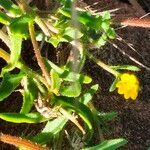Compact shrub or small tree, 0.7-4.5 m high; branches grey, smooth, rigid, spiny, spreading. Leaves 1-jugate, rarely simple, fascicled on spur-branchlets, petiolate, greyish green, obovate to oblong-obovate, finely notched at apex; margins entire, revolute. Flowers in clusters of 1-3, pedicellate. Calyx 5-lobed, lobes short, rounded, minutely mucronate. Corolla bright yellow, tube campanulate to funnel-shaped, lobe margins entire. Flowering time Sept.-Jan. Fruit a beaked capsule, brown, smooth, thin-walled. Seeds winged.
Corolla bright yellow with a campanulate to funnel shaped tube c. 15 mm. long, the lower cylindrical portion included in the calyx, outside glabrous, inside pilose in the throat and below the insertion of the stamens; lobes 9–16 mm. wide, subcircular, spreading, margin ciliate.
Small tree or shrub, 1.0-4.5 m high. Leaves simple or 1-jugate, fascicled on small cushions (abbreviated shoots); blade obovate to oblong-obovate; petiole ± 2-6(-8) mm long. Flowers: corolla bright yellow; Jul., Oct., Nov. Fruit a ‘pod-like' capsule.
Stiffly branched, spiny shrub, up to 4.5 m tall. Leaves in tufts, obovate, on short petioles, margins revolute. Flowers 1-3 on short shoots, showy, funnel-shaped, 20-30 mm long, golden-yellow. Fruit narrow and flattened, seeds papery winged.
Leaves 1-jugate rarely simple, fascicled on small cushions; petioles 2–6(8) mm. long; leaflets 4–19 × 2–6 mm. obovate to oblong-obovate, greyish-green, rounded often notched at the apex, tapering at the base, margins entire revolute.
Small tree or shrub, 1.0-4.5 m high. Leaves simple or 1-jugate, obovate to oblong-obovate, fascicled on small cushions, petiole ± 2-6(-8) mm long. Flowers bright yellow; July and October to November.
A shrub or small tree. It grows 1-4.5 m tall. The branches are rigid, spreading and spiny. There are usually 1-3 flowers on each cushion. They are bright yellow.
Rigid, spiny shrub to 4.5 m. Leaves fascicled, obovate, margins revolute. Flowers 1-3 on short shoots, funnel-shaped, yellow. Seeds papery winged.
Stamens adnate up to c. 10 mm. from the base of the corolla tube; filaments 3–6 mm. long; anthers 3.5–4 mm. long, slightly exserted.
Compact shrub or small tree 1–4.5 m. tall, with rigid spreading spiny and greyish branches.
Calyx 3–4.5 mm. long, regularly 5-lobed; lobes short, rounded minutely mucronate.
Flowers usually in clusters of 1–3 on each cushion; pedicels up to 5 mm. long.
Capsule 4.5–6.5 × 1–1.5 cm., white brownish, long, beaked.
Seeds 1–1.5 × 1.5–2.5 cm. including the wings.
Ovary c. 1.5 mm. long; style 14–21 mm. long.


